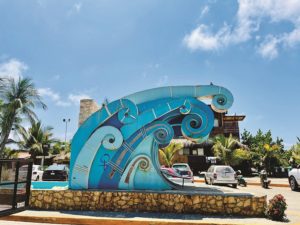I spent a good part of my late teens and early 20s traveling and surfing in Central America. I followed word-of-mouth suggestions on where to find the next good wave and colorful town. Each little surf town and small city had its own flavor and style, but one thing was constant: a reverence for the wave.
In every restaurant, behind every bar, splashed in life size on cracked roadside walls were paintings of the wave. Not a wave. The wave. The wave on which the town was built.
Some were tripped-out and surreal, some hyper-realistic, others stylized impressions. The wave was the focus, the central image. The town, spreading out from it, growing from it. The waves in these murals took on a religious quality — an homage to something mystical, something bigger.
A wave can be the seed from which a community grows. It becomes a part of the place’s story and identity. It is revered like a founding father, a pivotal event in its history, or its claim to fame. Wellfleet’s oyster. P’town’s funky art vibe. Cape Cod’s beaches.
A properly shaped sandbar and its pleasing interaction with an ocean wave will become the base of an economy to feed, house, and entertain those who are drawn there to surf it. From this, what was once an empty beach may become a town.

A glaring example of this is the small city where I am writing this article. Puerto Escondido, Mexico was once a sleepy town of farmers, fishermen, and pirates hiding out from the law. In the late ’50s, a few surfers from Texas stumbled into town and “discovered” the perfect beaches and the consistent and, frankly, terrifying sand bottom barrels. The wave in Puerto Escondido is now one of the world’s most famous, growing in reputation and popularity, and it’s taken the town along with it.
“When I went there in 1972, there was almost nothing,” said my mom over a crackly phone line. “There was a single dirt road running along the beach and a few thatched-roof huts out by the point. We stayed there for $2 a night. A little boy would bring us fresh fish each day. We had to cross a river on a boat just to get to the town.”
There is an international airport here now. It’s crazy and overwhelming. Everyone I pass in the streets is carrying a surfboard, and the local language is more “surf lingo” than Spanish. The place has changed a lot, and not all of it for the better. Economic opportunity is not inherently wholesome. Yet everywhere I go, there’s the wave. Paintings of its likeness are on every slab of exposed concrete and recreated in swirls and splashes on the walls of hotels. The highway coming into town has a 300-foot-long mural dominated by a surfer riding the wave. Almost every sign in the street is made of an old board that the wave has snapped and spit out. The wave is recognized as the town’s founder, its mascot, its muse.
The cultural and economic value of waves has become more broadly recognized and measured in recent years. “Surfenomics” is a real term for the process used to quantify the worth waves have to surfers, businesses, and communities. In some places, the value of these waves has led to the establishment of marine sanctuaries. A seven-mile section of Portugal’s coast is now a “world surf reserve,” protected for its significance to the culture and economy of Portugal. The same is true of places in Peru, Australia, and California.
On the Outer Cape, we don’t have waves that the world will come to for surfing. It’s too fickle and often too cold. Even so, we have people running surf schools, opening surf shops, and working in industries that benefit from the beach and surf culture that permeate the Cape’s unique vibe. The magnetic draw our ocean and waves creates allows people to live here. It keeps our community alive. It is often the very thing that attracts new people to stay and create a life here.
The very term we use for new blood in our community, “wash-ashore,” suggests something the waves draw up and place on our beaches. Though not often recognized for it, our waves, rolling in day after day, always giving and asking for nothing in return, are a part of the soul of this place we call home.



